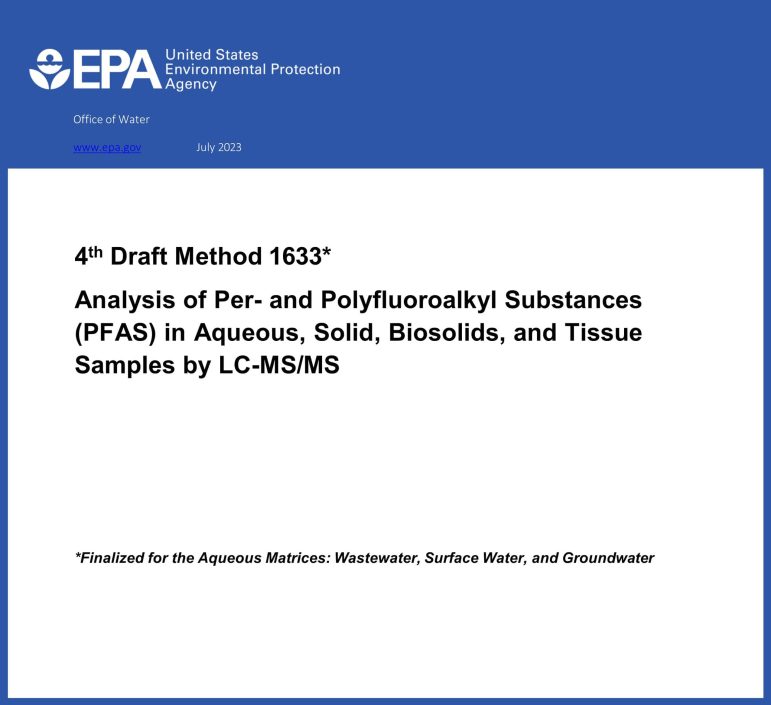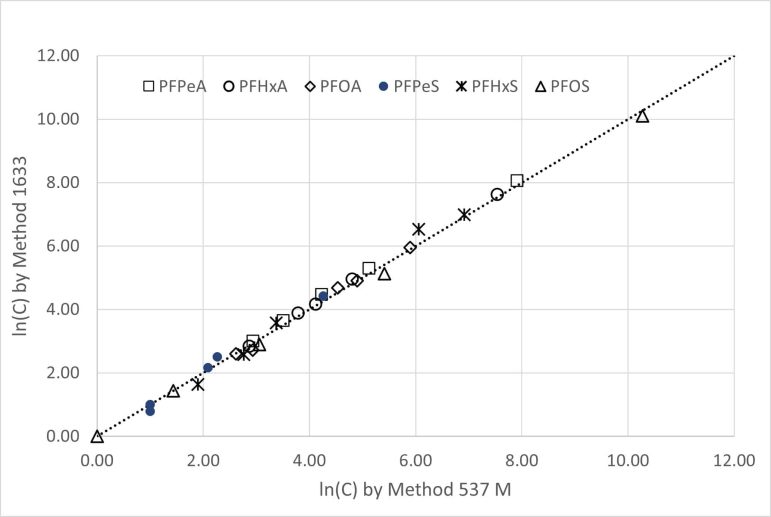
Method 1633 for PFAS in Aqueous Samples
EPA has published the fourth draft of the new analytical method for PFAS in environmental samples (Method 1633). Method 1633 will likely be finalized this fall and may be promulgated by early next year in 2024. So, it’s natural to ask what difference Method 1633 will make and what’s going to change.
By Scott Bell, Senior Environmental Engineer and Vice President (Ann Arbor, MI)
August 3, 2023
In July 2023, EPA published the fourth draft of the new analytical method for PFAS in environmental samples (Method 1633). EPA stated that although the method is still draft overall, the procedure is to be considered final for aqueous matrices (including wastewater, surface water, groundwater, and stormwater). To be clear, the finalization of the method does not mean that it will be immediately required for use in monitoring environmental compliance – that will happen once the method has been proposed and promulgated through rulemaking.
This latest development is a sure sign that EPA is very close to finalization and promulgation of the method. Current information indicates that we can expect the final method to be published this fall, and it may be required for PFAS analysis of environmental media as early as next year. Once that happens at the Federal level, the method will likely be adopted by state regulatory programs. So, what does all this mean for the regulated community?
This article provides background on the development of Method 1633 and looks at some key differences between Method 1633 and the lab-specific isotope dilution method (also known as 537 modified) that major commercial labs have been using for non-drinking water PFAS analysis over the last several years.
Why a New Method for PFAS?
One of the main reasons for the development of Method 1633 is to provide a standardized method for analyzing PFAS in environmental samples. Before discussing some key differences between Method 1633 and current analytical methods, it may be useful to look at why Method 1633 is being developed. EPA published Method 537 for PFAS in drinking water in 2008 with an update (Method 537.1) in 2018, followed by a complimentary drinking water method in 2019 (Method 533) to include PFAS analytes that are not measured by Method 537.1, including several short-chain compounds. However, these drinking water methods are not intended or suitable for non-drinking water samples.
In the absence of an EPA-published method for non-drinking water PFAS analysis and in response to market demand, many commercial labs developed modified versions of Method 537 using isotope dilution methods, as we’ve written about previously. In many cases, labs followed quality control standards published by the Department of Defense Environmental Laboratory Accreditation Program (ELAP). Labs that wanted to provide their customers with the highest levels of quality assurance even went so far as to become certified under the DoD ELAP for PFAS analysis. All this means is that environmental samples analyzed using a 537-modified isotope dilution method by an ELAP-certified lab were reporting valid PFAS results using the best available analytical methods. However, the methods were still laboratory-specific and not standardized, which has the potential for different results from lab to lab. With Method 1633, there will be a consistent and standardized method for PFAS in environmental samples, which should settle questions about labs producing varying results.
What’s Going to Change with EPA Method 1633?
Method 1633 will likely be finalized this fall and may be promulgated by early next year. So, it’s natural to ask what difference Method 1633 will make or what’s going to change? Here are a few answers to that question:
- Analyte list – Method 1633 includes a standardized list of 40 PFAS analytes. Currently, labs typically report between 24 and 40 PFAS depending on the lab, and they may customize the reporting list to match state-specific analyte lists. Method 1633 will provide a uniformity that is currently lacking. And states that currently have their own minimum PFAS analyte lists will probably default to the Method 1633 analyte list when the method is promulgated. For example, Michigan has published a “recommended minimum analyte list” for PFAS, but it states that “when a final PFAS analytical method for wastewater is published in 40 CFR Part 136, this method will be required for sampling conducted under the CWA, including National Pollutant Discharge Elimination (NPDES) permits.”
- Detection limits – The current version of Method 1633 does not specify minimum detection limits, but it does specify analytical quality standards that each lab must meet. As part of our effort to understand how switching to Method 1633 might affect our investigations, we’ve submitted some split aqueous samples for analysis using both the 537 modified method and draft Method 1633. Based on the limited data set we have so far, it appears that the method detection limits (MDLs) for Method 1633 are generally higher than those for 537 modified. In most cases, however, the Method 1633 MDLs are still well below applicable criteria for regulated PFAS analytes.
- Turnaround time – Most commercial labs offering the draft Method 1633 analysis are currently predicting longer turnaround times compared to the 537 modified method. For example, a national commercial lab we frequently work with states that the turnaround time for the draft Method 1633 will be 4-5 weeks compared to 2-3 weeks for the 537 modified method. This longer turnaround time is likely due to the more intensive analytical effort required for quantifying 40 analytes and the more stringent quality control criteria required by Method 1633.
- Cost – Labs currently charge about a third more per sample for the draft Method 1633 than the 537 modified method. For our work, this has meant paying about $400 per aqueous sample, compared to around $300 each for aqueous samples.
Will Method 1633 Give Me Different Results?
One question about Method 1633 that we often hear, after questions about cost, is whether Method 1633 will give different results than the currently used methods, like the 537 modified method. To better understand what the answer to this question might be, we have been submitting randomly selected split samples of groundwater and soil, at our own expense, to be analyzed using the draft Method 1633 in parallel with the primary samples being analyzed with the 537 modified method. We only have results for six split samples so far. The results are not scientifically conclusive, but they are interesting and may help answer this question. The scatter plot below compares the results for six commonly detected PFAS (PFPeA, PFHxA, PFOA, PFPeS, PFHxS, and PFOS) for four groundwater and two stormwater samples. Because the data represented here vary over orders of magnitude, a lognormal transformation was used for plotting.

As shown on the plot, draft Method 1633 and the 537 modified method yield similar results. There is very little scatter among the data points. The data tend to follow the 1:1 line represented by the dashed line, suggesting little or no bias from one method to the other. Based on these examples, it appears that changing to the new Method 1633 will not significantly affect data results, at least for aqueous samples. The same may not be true for solid matrix samples like soil, and we are in the process of collecting similar split sample data for soil.
The Takeaways
It appears the most significant change ahead when Method 1633 is finalized and promulgated, will be an increase in analytical cost and turnaround time. Costs may come down a little when service providers finally catch up with market demand; however, that will not likely happen for several years. In terms of sample results, we do not expect a significant change, at least as far as aqueous media are concerned.
If you have any questions about PFAS analysis methods or regulations or would like to discuss your PFAS-related needs, please feel free to contact me at sbell@limno.com.
This article is the eleventh in a series of articles authored by LimnoTech staff on PFAS-related issues. Follow us on LinkedIn and check the Insights & Perspectives page on our website for more information and updates. Links to the other PFAS articles in this series are provided below:
Sampling for PFAS Requires Caution
PFAS Analysis – The New Wild West
Aviation and PFAS – What’s the Connection?
PFAS – The Next Wastewater Utility Challenge?
Should Municipalities Worry About PFAS?
Key Considerations for PFAS Field Investigations
PFAS – How Low Can You Go? Now We Know!
Scott Bell, PE, is the Vice President of Business Operations and a Senior Environmental Engineer. Scott has been with LimnoTech since 1992. He manages projects for various industrial, municipal, and federal clients. Scott has technical expertise in environmental remediation and restoration and is currently LimnoTech’s practice leader for PFAS and emerging contaminants. Throughout his career at LimnoTech, Scott planned and executed scores of hydrologic and hydraulic engineering, water quality management, wastewater discharge impact analysis, stormwater management, and engineering feasibility evaluation projects across North America. In addition to his work with LimnoTech, Scott has been an adjunct lecturer in environmental engineering design at the University of Michigan. He has taught professional development courses for the Engineering Society of Detroit, delivered numerous technical papers and presentations, and served on several professional boards and committees. Scott is a licensed professional engineer and a Board-Certified Environmental Engineer by the American Academy of Environmental Engineers.




